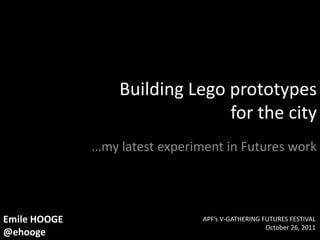Building Lego prototypes for the city
- 1. Building Lego prototypes for the city …my latest experiment in Futures work Emile HOOGE APF’s V-GATHERING FUTURES FESTIVAL October 26, 2011 @ehooge
- 2. I STARTED WITH A FEW QUESTIONS…
- 3. Can we talk about the future of cities and avoid buzz words?
- 4. futurist engineer artist urbanist mayor designer assets manager banker dog? child? Can we get different people to work together on the future of cities?
- 5. City Pulse project by MIT Senseable City Lab Can we tackle the whole system of the city in just a few hours?
- 6. Mandelbrot set Can we think about the future from top down AND from bottom up?
- 7. Can we produce futures work with social innovation, and reciprocally?
- 8. I WENT FOR AN EXPERIMENT…
- 9. Stage 1 Gathering a group
- 10. Stage 2 Learning a new language Denotation : “a car” Connotation : ”interdependence” Special thanks to David Gauntlett for some pics and giving me the idea of using Lego in the first place!
- 11. and many more… Stage 3 Building prototypes of social innovations “urban rest place” “chariot-sharing for personal goods transport” “neighbourhood networked windows”
- 12. Stage 4 Putting 4 prototypes together in a city
- 13. This future city: Stage 5 - links innovations at multiple scales in a fractal way Building future cities - introduces serendipity and messiness in planning around the prototypes
- 14. This future city: Stage 5 - facilitates networking and citizen empowerment Building future cities - promotes local citizen-champions around the prototypes - designs public space to accommodate pop-up or mobile services
- 15. This future city: Stage 5 - creates shareable resources and infrastructures Building future cities - organises new types of public-private-community partnerships around the prototypes - makes political decision about some places and services that are regarded as Commons - develops local alternative currencies to manage the Commons and support shareable lifestyles
- 16. The rule was: build something before you talk about it! Stage 6 Sharing insights and foresights
- 17. I CAME TO SOME CONCLUSIONS… My mother thinks I’m still playing with Lego while I’m actually doing some proper futures work (or not?)
- 18. CONTRIBUTION TO DEALING WITH PRECONCEPTIONS by using Lego as a new common language by applying induction rather than deduction by getting people to speak about what they have built CONTRIBUTION TO VISIONNING A DESIRABLE FUTURE by combining desirable innovations by engaging a diverse audience CONTRIBUTION TO A SYSTEMS APPROACH by making something first and then presenting something whole by linking prototypes together
- 19. CONTRIBUTION TO FOCUSING ON VALUES AND MEANING by placing a « common » in the centre of the scene by asking the « why? » question as well as the « how? » question by giving people time to think while they build with their hands CONTRIBUTION TO PREPARING FOR ACTION by using a hands-on approach and actually prototyping ideas by working with people involved in their communities by building a future vision of the city supporting desired innovations
- 20. BIAS INDUCED BY THE METHOD Focusing on innovation as main driver towards the future Focusing on the local before thinking global Focusing on feelings and emotions rather than facts and figures LIMITS IN SCALABILITY Maintaining the momentum (will the fun factor eventually die out?) Replicating on a large scale (over time and space)
- 21. Rose Biggin a.k.a. Banksy ;-) … IT DID CHALLENGE SOME URBAN CONVENTIONS Emile HOOGE @ehooge





















